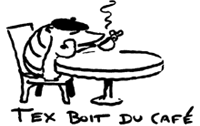Determiners
Partitive articles
forms
There are three partitive articles in French.
| Masculine: du | du pain | (some) bread |
| Feminine: de la | de la viande | (some) meat |
| Masculine or feminine before a vowel: de l’ | de l‘ail (m.) de l‘eau (f.) |
(some) garlic (some) water |

uses
Partitive articles are used both in English and in French to express quantities that cannot be counted. While the indefinite article (un, une, des) is used with countable quantities (un oeuf, deux oeufs …), the partitive article is used before mass nouns, nouns that are indivisible or uncountable. In English the article ‘some’ is often omitted.
| Edouard: Comme dessert, nous avons de la mousse au chocolat, de la glace parfumée à la vanille et du sorbet à l’ananas. | Edouard: For dessert, we have (some) chocolate mousse, vanilla ice cream, and pineapple sorbet. |
While the definite article designates something in its totality, or as a whole, the partitive article designates a part of the whole. Note that depending on what you want to say, the same noun may be introduced by a definite, indefinite, or a partitive article. Compare these examples:
| Edouard: Vous prenez du vin, n’est-ce pas? | partitive article |
Edouard: You are having (some) wine, aren’t you? (a quantity that is not specified) |
||
| Le vin rouge est bon pour la santé! | definite article |
Red wine is healthy! (‘wine’ in general) |
||
| En fait, nous avons un Beaujolais nouveau ou un Chambertin, un Châteauneuf-du-Pape, ou j’ai un excellent Médoc pour vous, ou un tout petit vin gris de Savoie. | indefinite article |
In fact, we have a Beaujolais nouveau, or a Chambertin, a Châteauneuf-du-Pape, or I have an excellent Médoc for you, or a little grey wine from Savoy. (These are items on the wine list, a countable quantity) |

after the negative
In negative sentences, du, de la, des, de l’ change to de:
| Joe-Bob mange de la viande. | Tammy ne mange pas de viande. | Joe-Bob eats meat. Tammy does not eat meat. |
||
| Tex boit du café. | Tammy ne boit jamais de café. | Tex drinks coffee. Tammy never drinks coffee. |
||
| Il y a encore du vin. | Il n‘y a plus de vin. | There is some wine left. There is not any wine left. |

The partitive and indefinite articles may be used in negative sentences, however, to emphasize the contrasting positive noun. For example:
| Entre Tex et Tammy, ce n’est pas de l’amitié, c’est de l’amour! | Between Tex and Tammy, it is not friendship, it is love! | |
| Edouard sert du poulet, pas des escargots! | Edouard serves chicken, not snails! |
Notice the use of the partitive articles in the following dialogue.
| Tammy est au téléphone: Allô, Edouard? Je reçois des amis ce soir. Je voudrais faire des crêpes, mais j’ai oublié la recette. Tu peux m’aider? | Tammy is on the phone: Hello, Edouard? I’m having some friends over tonight. I would like to make some crêpes, but I’ve forgotten the recipe. Can you help me? | |
| Edouard: Rien de plus facile! Tu mélanges de la farine et des oeufs. Tu ajoutes ensuite du lait, du sel et de l’huile. Tu verses cette pâte dans une poêle. Quand la pâte est cuite, tu garnis la crêpe avec du fromage râpé, du jambon, ou des cèpes. Mais n’oublie pas Tammy, avec des crêpes, on ne boit pas de vin. Il faut boire du cidre et porter une coiffe bretonne! | Edouard: No problem! Mix some flour and eggs. Add some milk, some salt and some oil. Pour this batter in a pan. When the batter is cooked, fill the crêpe with some grated cheese, some ham, or cepes (mushrooms). But don’t forget Tammy, with crêpes, you don’t drink wine. You have to drink cider and wear a Breton hat! |

